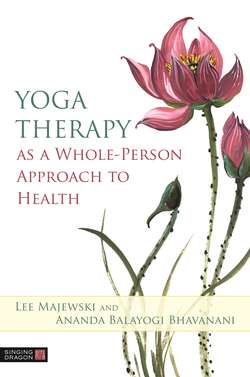Читать книгу Yoga Therapy as a Whole-Person Approach to Health - Lee Majewski - Страница 38
На сайте Литреса книга снята с продажи.
Managing the breath
ОглавлениеThe vital life force acts as a catalyst in all our activities, and yoga, through the enhancement of this energy, attempts to help achieve optimal health and healing. Pranayama may thus be defined as the art and science of controlled, conscious expansion of such vital energy through managing the breath. Masters of ancient (Vedic) times placed great importance on pranayama and advocated its practice in order to unleash the inner potential energy (kundalini). Indian culture lays great emphasis on prana and pranayama—ancient Vedic literature says, “God is breath” as well as “Breath is life and life is breath.”11 Atharvana Veda even goes on to state, “prana is the fundamental basis of whatever is, was and will be.”
In the Prasnopanishad we can find the following statement: “All that exists in all the three worlds is under the governance of prana.” It is said in the Shiva Swarodaya, “The life force (prana) verily is one’s greatest friend, companion and there is no greater kinsman than the life force.”12 In the Yoga Vashista, sage Vashistha says that when the energy of the life force (prana) is restricted, then the mind dissolves, like a shadow of a thing when the thing is absent.13
In the Hatha Yoga Pradipika, Yogi Swatmarama says, “When respiration is disturbed, the mind gets disturbed. When breath is steady and undisturbed, mind is also steady and undisturbed. By consciously controlling respiration, the Yogi attains steadiness of mind” (II:2).14 He also says, “Mind is the master of the senses, while the breath is its Lord. Mastery of the breath lies in its absorption that depends on conscious vibrations induced during smooth, steady inhalation and exhalation” (IV:29). He lists the important breath-based energy practices (kumbhaka) such as skull shining breath (kapalbhati), sun-cleaving breath (surya bhedana), victorious breath (ujjayi), hissing breath (sitkari), beak tongue breath (sitali), bellows breath (bhastrika), and bee-sounding breath (bhramari), among others.15 He also warns us that, although pranayama can eradicate all diseases, it may cause a multitude of problems if performed improperly (II:16).
According to the Hatha Yoga Pradipika, when the nerves are purified by pranayama, the body becomes slender and lustrous, gastric fire increases, inner sounds are heard, and excellent health is attained. Chapter II, verses 36–68 describe the benefits of each pranayama:
• Kapalbhati balances kapha, stimulates blood circulation, slows peristaltic movement, and improves digestion.
• Surya bhedana cures vata disorders, purifies the sinuses and blood, removes parasites, and rejuvenates cells.
• Ujjayi is said to remove the disorders of phlegm and structural elements (dhatus), increases stamina and agility, and alleviates nerve disorders, stress, and depression.
• Sitkari alleviates hunger, thirst, the need for sleep, or lassitude.
• Sitali balances pitta, relieves colic, spleen disorders, fever, tumors, and bile disorders, and neutralizes even the most dangerous of poisons.
• Bhastrika balances all three doshas (vata, pitta, kapha), pierces three granthis, has the capacity to cure phlegm, bile, and gas disorders, infuses vigor, stamina, and alertness, improves memory, removes depression, and helps increase the gastric fire.16
The practice of pranayama helps to regulate our emotions and stabilize the mind, which is said to be as restless as a “drunken monkey stung by a scorpion.” Emotions and breath are known to have a deep relationship. When we get angry, we can experience that our breathing becomes rapid, and it is slower when we are cool and relaxed. Thus the slow, rhythmic, and controlled breathing in pranayama leads to the emotional control seen in dedicated yoga practitioners. Conscious, deep, and regular breathing can synchronize and reinforce inherent cardiovascular rhythms and modify baroreflex sensitivity, which may be attained by practicing ujjayi and pranava.17 The sound-based vibrational breaths (pranava and bhramari18) enable the manifestation of an inner harmony that results in the attainment of a state of mental calmness.
According to Dr Swami Gitananda Giri, the inherent message of pranayama can be summarized as follows: “There is an absolute and direct correlation between the way the man breathes and his energy level, the length of his lifespan, the clarity and subtlety of the thoughts, and the quality of the emotions.”19
